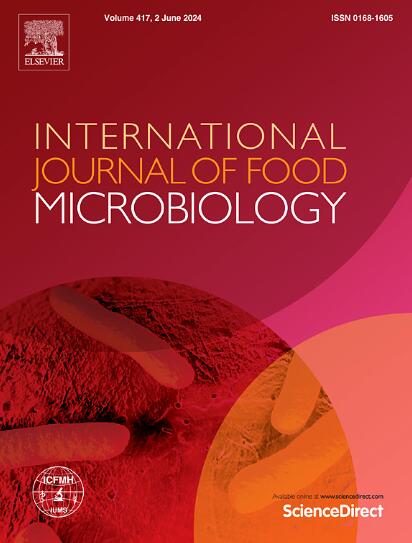传统韩国米醋产品的宏基因组学和元代谢组学分析显示,生产者之间存在很大差异
IF 5.2
1区 农林科学
Q1 FOOD SCIENCE & TECHNOLOGY
International journal of food microbiology
Pub Date : 2025-05-26
DOI:10.1016/j.ijfoodmicro.2025.111283
引用次数: 0
摘要
谷物醋已经使用了数千年,特别是在亚洲国家。这些醋仍然以传统的方式生产,在开放的大桶中,在非无菌条件下进行自发的,连续的,酒精和醋酸发酵过程,这可能导致不稳定和不一致的风味和质量。本研究采用高通量扩增子测序和散弹枪宏基因组测序,结合元代谢组学分析,对两个生产商(A和B)从蒸米饭到米醋的完整韩国传统米醋产品的微生物多样性进行了表征。基于宏基因组组装基因组的功能分析提供了对所涉及的不同微生物的遗传潜力的见解。生产商A使用传统的发酵剂nuruk和种子醋分别开始酒精和醋酸发酵阶段,即使使用不同的发酵容器,也能高度控制生产。生产者B只使用nuruk开始醋生产,其中一个产品的醋酸细菌自发接种失败。添加nuruk导致大米淀粉糖化和酒精发酵同时进行,其特征是生产者特有的霉菌、酵母和乳酸菌(LAB)。在两个生产商的醋酸发酵阶段,发现了一种与巴氏杆菌有关的新型醋酸杆菌。同时存在几个LAB物种使得很难将它们与特定代谢物的产生联系起来。此外,对风味至关重要的酯形成有贡献的物种尚不清楚,需要进一步研究。本文章由计算机程序翻译,如有差异,请以英文原文为准。
Metagenomic and meta-metabolomic analysis of traditional Korean rice vinegar productions shows a large variability between producers
Cereal vinegars have been used for thousands of years, especially in Asian countries. These vinegars are still produced in a traditional way by a spontaneous, consecutive, alcoholic and acetic acid fermentation process in open vats under non-sterile conditions, which can lead to an unstable and inconsistent flavor and quality. The present study characterized the microbial diversity of complete, traditional Korean rice vinegar productions at two producers (A and B), from steamed rice to rice vinegar, applying high-throughput amplicon-based and shotgun metagenomic sequencing, in combination with meta-metabolomic analysis. Functional analysis based on metagenome-assembled genomes provided insights into the genetic potential of the different microorganisms involved. Producer A used nuruk, a traditional starter, and seed vinegar to start the alcoholic and acetic acid fermentation phases, respectively, which resulted in highly controlled productions even when different fermentation vessels were used. Producer B used only nuruk to start the vinegar productions, and the spontaneous inoculation of acetic acid bacteria did fail in one of the productions. The addition of nuruk resulted in a simultaneous rice starch saccharification and alcoholic fermentation phase characterized by producer-specific moulds, yeasts, and lactic acid bacteria (LAB). During the acetic acid fermentation phase at both producers (a) novel Acetobacter species, related to A. pasteurianus was found. The simultaneous presence of several LAB species made it hard to link them with the production of specific metabolites. Also, the species contributing to ester formation, important for the flavor, was not clear and requires further research.
求助全文
通过发布文献求助,成功后即可免费获取论文全文。
去求助
来源期刊
CiteScore
10.40
自引率
5.60%
发文量
322
审稿时长
65 days
期刊介绍:
The International Journal of Food Microbiology publishes papers dealing with all aspects of food microbiology. Articles must present information that is novel, has high impact and interest, and is of high scientific quality. They should provide scientific or technological advancement in the specific field of interest of the journal and enhance its strong international reputation. Preliminary or confirmatory results as well as contributions not strictly related to food microbiology will not be considered for publication.

 求助内容:
求助内容: 应助结果提醒方式:
应助结果提醒方式:


